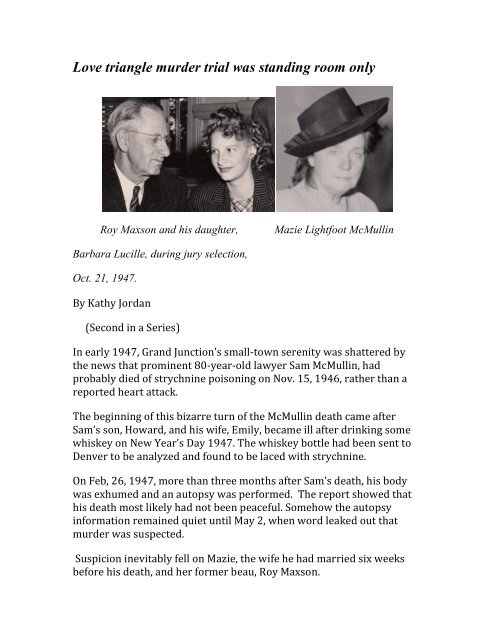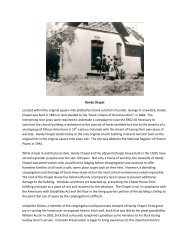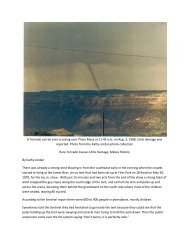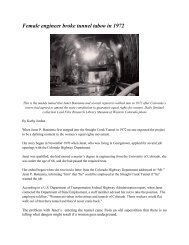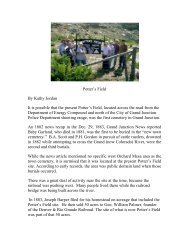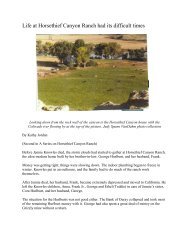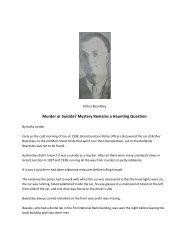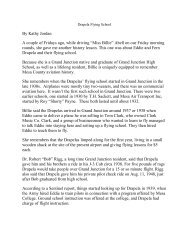Love triangle murder trial was standing room only - North 7th Street ...
Love triangle murder trial was standing room only - North 7th Street ...
Love triangle murder trial was standing room only - North 7th Street ...
You also want an ePaper? Increase the reach of your titles
YUMPU automatically turns print PDFs into web optimized ePapers that Google loves.
<strong>Love</strong> <strong>triangle</strong> <strong>murder</strong> <strong>trial</strong> <strong>was</strong> <strong>standing</strong> <strong>room</strong> <strong>only</strong><br />
Roy Maxson and his daughter,<br />
Mazie Lightfoot McMullin<br />
Barbara Lucille, during jury selection,<br />
Oct. 21, 1947.<br />
By Kathy Jordan<br />
(Second in a Series)<br />
In early 1947, Grand Junction’s small‐town serenity <strong>was</strong> shattered by<br />
the news that prominent 80‐year‐old lawyer Sam McMullin, had<br />
probably died of strychnine poisoning on Nov. 15, 1946, rather than a<br />
reported heart attack.<br />
The beginning of this bizarre turn of the McMullin death came after<br />
Sam’s son, Howard, and his wife, Emily, became ill after drinking some<br />
whiskey on New Year’s Day 1947. The whiskey bottle had been sent to<br />
Denver to be analyzed and found to be laced with strychnine.<br />
On Feb, 26, 1947, more than three months after Sam’s death, his body<br />
<strong>was</strong> exhumed and an autopsy <strong>was</strong> performed. The report showed that<br />
his death most likely had not been peaceful. Somehow the autopsy<br />
information remained quiet until May 2, when word leaked out that<br />
<strong>murder</strong> <strong>was</strong> suspected.<br />
Suspicion inevitably fell on Mazie, the wife he had married six weeks<br />
before his death, and her former beau, Roy Maxson.
Meanwhile, Police Chief Joe Keith had been checking drug stores<br />
between February and May to see who had purchased strychnine. Keith<br />
found that Roy had purchased strychnine from Carlson’s Drug Store in<br />
Clifton.<br />
Police arrested Roy on May 16 for first‐degree <strong>murder</strong>, and during the<br />
interrogation Roy admitted that he <strong>was</strong> in love with Mazie. He also<br />
admitted that from time to time he had looked in McMullin’s front<br />
window and watched Sam with Mazie, in a beautiful beribboned<br />
negligee, sitting on Sam’s lap. However, Roy continued to deny strongly<br />
that he had anything to do with the crime.<br />
As time went on, attention shifted to Mazie, and she <strong>was</strong> arrested June<br />
24, 1947, and also charged with first‐degree <strong>murder</strong>.<br />
Charles J. Moynihan of Montrose, somewhat famed as a criminal lawyer<br />
throughout Colorado, became Roy’s lawyer.<br />
Mazie had hired E.B. Adams of Grand Junction, another colorful and<br />
highly respected attorney, as her lawyer. But after the first meeting with<br />
Mazie, Adams turned the case over to the late Charles Traylor, who had<br />
joined Adams’ law firm <strong>only</strong> a few months before. According to<br />
Traylor’s memoirs of the <strong>trial</strong>, when he and Adams went to the jail to<br />
meet with Mazie for the first time, her dramatics were too much for<br />
Adams and he told Traylor “Boy, I am too old for this. You take over.”<br />
Unknown to Mazie’s lawyers, she had been taken to St. Mary’s Hospital a<br />
few nights after her arrest. When Traylor learned that Pentothal had<br />
been administered without her counsel present, he <strong>was</strong> able to have her<br />
statement withheld from evidence. That statement had been a pivotal<br />
point in the prosecution’s case against Mazie.<br />
Roy almost caught a break when Adams <strong>was</strong> going over the pathology<br />
report and noticed that Sam’s brain had not been opened during the<br />
autopsy. This meant that a pathologist could not conclude beyond<br />
reasonable doubt that Sam’s death had been due to an aneurysm.<br />
Somehow Deputy District Attorney Cecil Haynie of Grand Junction, the<br />
prosecutor, learned that the defense planned to use that fact to argue<br />
Maxson’s innocence. So late at night on Sept. 28, 1947, under a cloak of
secrecy, the prosecution exhumed Sam’s body a second time, and his<br />
brain <strong>was</strong> opened. No aneurysm <strong>was</strong> found.<br />
Roy’s <strong>trial</strong> started on Oct. 23, 1947, before a jury of nine men, three<br />
women, and one male alternate. The <strong>trial</strong> played to “<strong>standing</strong> <strong>room</strong><br />
<strong>only</strong>,” and seats were in such demand that people brought their lunches<br />
so they didn’t lose their seats.<br />
The jury apparently didn’t pay much attention to fingerprint testimony<br />
gleaned from 19 anonymous letters sent to Sam and Howard after<br />
Moynihan pointed out there were not enough matching characteristic to<br />
say positively the fingerprints were Roy’s. No prints were taken from<br />
the whiskey bottle.<br />
Roy took the stand in his own defense, to testify that Mazie had asked<br />
him to take the blame for the <strong>murder</strong>.<br />
After a two‐weeks <strong>trial</strong>, Roy <strong>was</strong> found not guilty. One juror afterwards<br />
said there <strong>was</strong> no evidence placing the defendant in the McMullin home<br />
nor <strong>was</strong> there any evidence that he had known where the whiskey<br />
bottle <strong>was</strong>.<br />
On Dec. 15, 1947, Traylor received notice from then‐District Attorney<br />
Allen Brown that he couldn’t convict Mazie if Roy couldn’t be convicted,<br />
and the charges against her were dismissed.<br />
By 1950 Mazie had sold her house on Rood Ave. and moved to<br />
California. There <strong>was</strong> no information available on Jenny Wiley, the<br />
housekeeper. Roy Maxson died in Grand Junction on Dec. 7, 1972.<br />
Howard and Emily lived in the house at 627 Grand Ave. until moving to<br />
a new home on Mira Vista in 1956. Victoria and David Canaday<br />
purchased the house in 1976 and it <strong>was</strong> the home to their photography<br />
studio, The Studio 119. Victoria sold the house early this year and it<br />
currently houses the Salon Capelli.<br />
As to the guilt or innocence of any of the principals in the case, Traylor<br />
summed it up in his memoirs: “So then the question comes up: Who did<br />
it I don’t know. Any suggestions”


